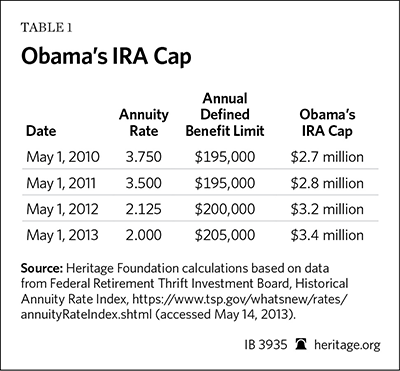President Obama proposes to cap the total value of taxpayers’ defined-contribution retirement savings accounts—such as Individual Retirement Accounts (IRAs) and 401(k)s—according to the maximum benefit permitted under defined-benefit plans. In 2013, that would be around $3.4 million.[1]
This proposal would be a step backwards for savings policy, because it would increase the already sizeable bias that taxes impose on saving.
How They Work Today
Defined-contribution retirement savings vehicles, such as 401(k)s, 403(b)s, and IRAs, are tax-deferred, meaning income earners do not pay tax on income they contribute to qualified savings accounts today but defer the tax payment to the future when contributions and earnings are withdrawn in retirement.
There are annual limits on contributions to these plans. Taxpayers can contribute up to $5,500 to IRAs in 2013 tax-free. Self-employed individuals can contribute up to $51,000. Those with employer-sponsored 401(k)s and 403(b)s can contribute up to $17,500.
Today, there is no cap on the total value of these accounts. Under President Obama’s maximum permitted accumulation cap, however, once the combined value of all of a taxpayer’s retirement savings accounts hit the $3.4 million mark, he or she would no longer be allowed to contribute to them. That means the taxpayer would not receive any of the tax benefits these plans confer on additional saving. The President’s proposal is most likely to affect the self-employed, whose annual contribution limits are comparably higher, and investors whose investment allocation resulted in large earnings on their contributions.
How the President’s Proposal Would Work
The President’s proposal sets the tax-advantaged savings cap at the level sufficient to purchase an annuity that provides the maximum allowable retirement pension for defined-benefit plans. This is the maximum benefit a retired worker may receive in any given year from an employer-sponsored retirement plan.
The IRS adjusts the maximum benefit annually for inflation. In 2013, it is $205,000.[2] In the President’s proposal this corresponds to a $3.4 million total accumulation for a 62-year-old. Rather than set the cap at a fixed dollar value adjusted for inflation, the cap would fluctuate over time based on actuarial assumptions such as annuity discount rates. This means that the cap could drop to much lower levels.
The table below illustrates what cap could have been in effect in previous years and how the cap could fall with the annuity interest rate and the defined-benefit limit.[3]

Had Obama’s IRA cap been in effect in 2010, for example, income earners would not have been allowed to make any more contributions if the total value across their retirement savings accounts was about $2.7 million. As interest rates are expected to rise in future years from their current historic lows, Obama’s IRA cap could fall steeply below $3 million.
According to the President’s proposal, the cap would be determined at the end of a calendar year and would apply to contributions the following year. A taxpayer whose combined account value was at or above the cap in any given year would be allowed no further contributions, but the value in the account could continue to grow with investment earnings and gains.
If the cap were to increase beyond the accumulated value for such a taxpayer, further contributions would be allowed up until the new, higher cap is reached. If the cap fell as annuity rates increased, the taxpayer would be prohibited from making further contributions until the combined account value was below the cap again.
A $9 Billion Tax Increase
Obama’s cap would force taxpayers who want to save more than his cap permits to pay tax on income they otherwise would have saved in tax-preferred retirement savings accounts. This tax increase would fall mostly on high-income earners.
Taxpayers hit by the cap would have paid tax on the income they would have saved in their retirement savings accounts, plus the returns they earned on it, in the future when they withdrew money during their retirement. Thus, Obama’s cap shifts taxes from future years into the current 10-year budget window, which, according to the President’s budget, results in a tax increase of more than $9 billion over that span.[4]
Increases the Tax Bias Against Saving
The current tax code imposes multiple layers of taxation on saving and investing, which creates tremendous biases against both. Those biases are the major forces driving the lack of savings in the U.S.
When saving outside tax-preferred plans, taxpayers pay tax on the income they save. Then, they pay tax on the interest they earn from those savings. If they invest their savings, they pay tax on the dividends they earn. And when they sell their investments, they pay capital gains tax on the appreciation of their investments. These successive layers of taxation create an enormous disincentive to save.
IRAs, 401(k)s, and other tax-preferred retirement savings accounts reduce those disincentives by allowing taxpayers to make contributions with before-tax income and grow their earnings tax-free until they withdraw the accumulation in retirement. Congress should be working on ways to build on the success of these plans to further reduce the bias against saving for all purposes, especially considering how little most Americans have saved for retirement, rainy days, and investments such as housing. President Obama’s proposed cap on total accumulations, however, moves in the opposite direction by imposing a second cap on retirement savings in addition to the already existing cap on contributions.
Sets Bad Precedent
The President’s cap on retirement savings would set a bad precedent by establishing the false premise that retirement savings accounts should be capped.
This could start a misguided descent down a slippery slope that would end up making middle-class retirements less secure. Future Congresses and Presidents might decide to lower the cap further for short-term revenue reasons. If they lowered it far enough, the cap could discourage middle-class families from saving as much as they need during their retirements.
Eliminate Caps on Annual Contributions
IRAs, 401(k)s, and other tax-advantaged savings vehicles are major improvements over the tax code’s basic treatment of savings, but they maintain much of the savings bias in the tax code, because annual contributions to them are capped. And savers may only withdraw the money after turning 59 ½ or face penalties. Taxpayers wanting to save above these limits (or those who wish to withdraw for purposes other than retirement, such as buying a home) face the tremendous bias imposed by taxes for doing so.
Congress should allow taxpayers to save as much as they can every year tax-free for any purpose with no cap on the total value of their savings. They would pay tax only when they withdraw their savings to spend for whatever purpose they choose.[5]
As an intermediate step, rather than institute President Obama’s misguided cap, Congress should raise—or, better yet, eliminate entirely—the annual caps on contributions to retirement savings plans.
—Romina Boccia is Assistant Director of and Curtis S. Dubay is a Senior Analyst in Tax Policy in the Thomas A. Roe Institute for Economic Policy Studies at The Heritage Foundation.


